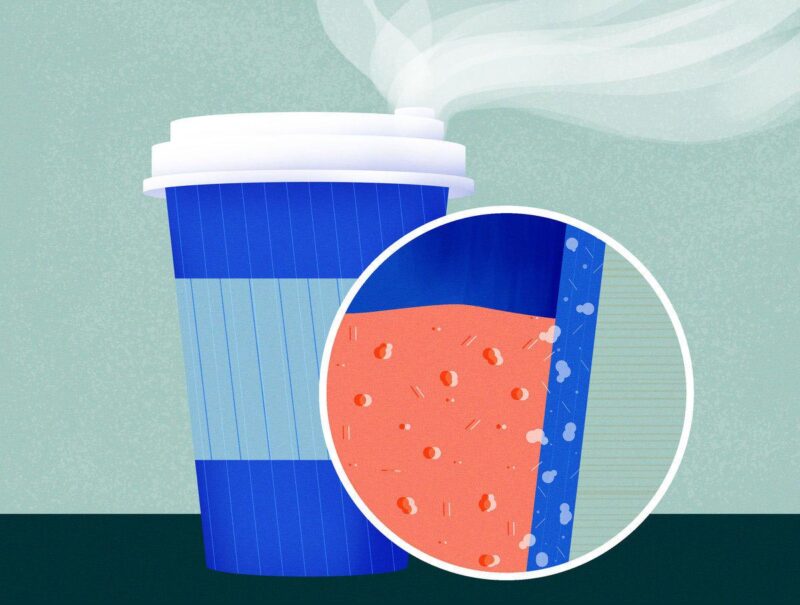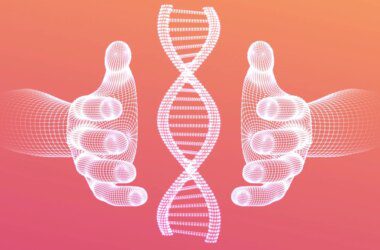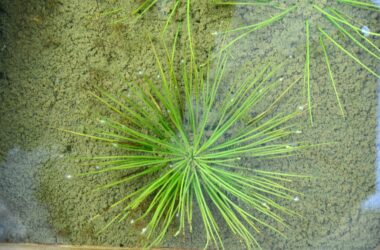
Les chercheurs du NIST ont analysé des tasses à boissons à usage unique, comme les tasses à café, qui peuvent libérer des trillions de nanoparticules, ou de minuscules particules de plastique, depuis le revêtement intérieur de la tasse lorsque l’eau est chauffée. Crédit : N. Hanacek/NIST
Les plastiques sont partout autour de nous, qu’il s’agisse des sacs d’épicerie que nous utilisons au supermarché ou des articles ménagers tels que les bouteilles de shampoing et de détergent. Les plastiques n’existent pas seulement sous forme de gros objets, mais aussi sous forme de particules microscopiques qui sont libérées par ces produits plus gros. Ces plastiques microscopiques peuvent se retrouver dans l’environnement et être ingérés par notre corps.
Des scientifiques du National Institute of Standards and Technology (NIST) ont analysé certains produits de consommation courante pour mieux comprendre ces plastiques microscopiques. Ils ont découvert que lorsque les produits en plastique sont exposés à l’eau chaude, ils libèrent des trillions de nanoparticules par litre dans l’eau.
Les chercheurs du NIST ont récemment publié leurs résultats dans la revue scientifique Environmental Science and Technology.
“La principale conclusion est qu’il y a des particules de plastique partout où l’on regarde. Il y en a beaucoup. Des trillions par litre. Nous ne savons pas si elles ont des effets néfastes sur la santé des personnes ou des animaux. Nous avons simplement une grande confiance dans leur présence”, a déclaré Christopher Zangmeister, chimiste au NIST.
Il existe de nombreux types différents de matières plastiquesmais ils sont tous constitués de polymères, qui sont des substances naturelles ou artificielles composées de grosses molécules reliées entre elles. Les scientifiques ont trouvé des particules microscopiques de ces grands plastiques dans de nombreux environnements, y compris les océans. Les chercheurs les classent en deux groupes : les micro et les nanoplastiques.

Images haute résolution des nanoparticules présentes dans les gobelets à usage unique, comme les tasses à café, à l’échelle du micromètre (un millionième de mètre). Crédit : C. Zangmeister/NIST, adapté par N. Hanacek/NIST
Les microplastiques sont généralement considérés comme inférieurs à 5 millimètres (0,2 pouce) de longueur et peuvent être vus à l’œil nu, tandis que les nanoplastiques sont inférieurs à un millionième de mètre (un micromètre) et la plupart ne peuvent même pas être vus avec un microscope standard. Des études récentes ont montré que certains produits de consommation qui contiennent des liquides ou interagissent avec eux, comme les biberons en polypropylène (PP) et les sachets de thé en nylon, libèrent ces particules de plastique dans l’eau environnante.
Dans leur étude, les chercheurs du NIST ont examiné deux types de produits commerciaux en plastique : les sacs en nylon de qualité alimentaire, tels que les doublures de cuisson – des feuilles de plastique transparent placées dans les moules à pâtisserie pour créer une surface antiadhésive qui empêche la perte d’humidité – et les tasses à boissons chaudes à usage unique, telles que les tasses à café. Les gobelets analysés étaient recouverts de polyéthylène basse densité (LDPE), un film plastique souple et flexible souvent utilisé comme revêtement.
Les gobelets à boisson revêtus de PEBD ont été exposés à de l’eau à 100 degrés Celsius (212 degrees Fahrenheit) for 20 minutes.
To analyze the nanoparticles released from these plastic products, the researchers first needed to determine how to detect them. “Imagine having a cup of water in a generic to-go coffee cup. It could have many billions of particles, and we would need to figure out how to find these nanoplastics. It’s like finding a needle in a haystack,” Zangmeister said.
So, he and his colleagues had to use a new approach. “We used a way of taking the water that’s in the cup, spraying it out into a fine mist, and drying the mist and all that’s left within the solution,” said Zangmeister. Through this process, the nanoparticles are isolated from the rest of the solution.
The technique itself has previously been used to detect tiny particles in the atmosphere. “So, we’re not reinventing the wheel but applying it to a new area,” said Zangmeister.
After the mist was dried, the nanoparticles in it were sorted by their size and charge. Researchers could then specify a particular size, for example nanoparticles around 100 nanometers, and pass them into a particle counter. The nanoparticles were exposed to a hot vapor of butanol, a type of alcohol, then cooled down rapidly. As the alcohol condensed, the particles swelled from the size of nanometers to micrometers, making them much more detectable. This process is automated and run by a computer program, which counts the particles.
Researchers could also identify the chemical composition of the nanoparticles by placing them on a surface and observing them with techniques known as scanning electron microscopy, which takes high-resolution images of a sample using a beam of high-energy electrons, and Fourier-transform infrared spectroscopy, a technique that captures the infrared-light spectrum of a gas, solid or liquid.
All these techniques used together provided a fuller picture of the size and composition of the nanoparticles.
In their analysis and observations, the researchers found that the average size of the nanoparticles was between 30 nanometers and 80 nanometers, with few above 200 nanometers. Additionally, the concentration of nanoparticles released into hot water from food-grade nylon was seven times higher compared with the single-use beverage cups.
“In the last decade scientists have found plastics wherever we looked in the environment. People have looked at snow in Antarctica, the bottom of glacial lakes, and found microplastics bigger than about 100 nanometers, meaning they were likely not small enough to enter a cell and cause physical problems,” said Zangmeister.
“Our study is different because these nanoparticles are really small and a big deal because they could get inside of a cell, possibly disrupting its function,” said Zangmeister, who also stressed that no one has determined that would be the case.
The U.S Food and Drug Administration (FDA) regulates the plastics that touch the food we eat or the water we drink. The agency has standards and safety measures in place to determine what’s safe. The FDA’s researchers run rigorous tests on these plastics and measure how much plastic mass is lost when exposed to hot water. For example, the FDA has determined that food-grade nylon (such as that used in tea bags) can safely lose up to 1% of its mass under high-temperature conditions. In the NIST study using their new technique, the researchers found one tenth of a percent of the mass was lost, which is significantly below current FDA limits for what’s considered safe.
Zangmeister noted there isn’t a commonly used test for measuring LDPE that is released into water from samples like coffee cups, but there are tests for nylon plastics. The findings from this study could help in efforts to develop such tests. In the meantime, Zangmeister and his team have analyzed additional consumer products and materials, such as fabrics, cotton polyester, plastic bags and water stored in plastic pipes.
The findings from this study, combined with those from the other types of materials analyzed, will open new avenues of research in this area going forward. “Most of the studies on this topic are written toward educating fellow scientists. This paper will do both: educate scientists and perform public outreach,” said Zangmeister.
Reference: “Common Single-Use Consumer Plastic Products Release Trillions of Sub-100 nm Nanoparticles per Liter into Water during Normal Use” by Christopher D. Zangmeister, James G. Radney, Kurt D. Benkstein and Berc Kalanyan, 20 April 2022, Environmental Science and Technology.
DOI: 10.1021/acs.est.1c06768



